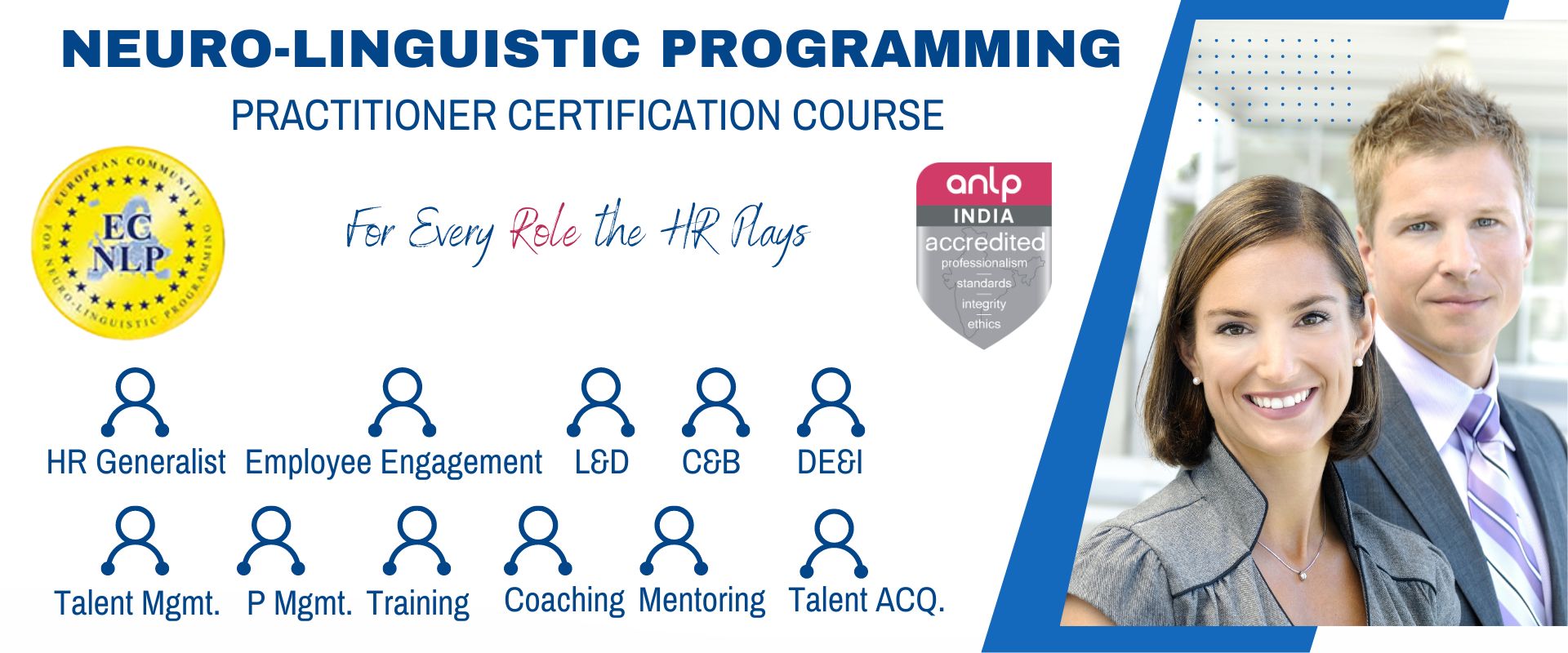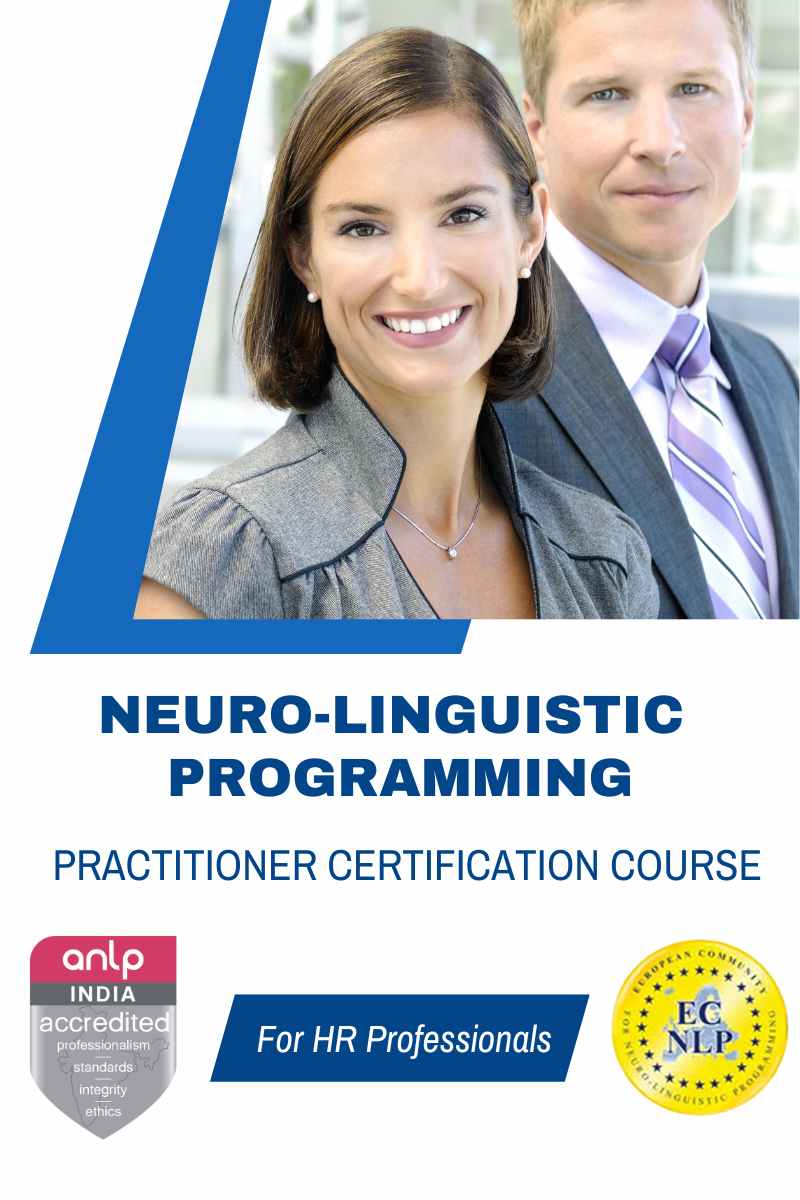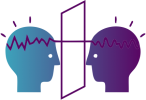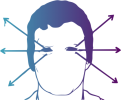Contact Us

Enquire Now: Call – +91-7083480800 or Email – info@neurointelligence.com



The basic structure of NLP can be defined with three prime elements

NEURO (The Mind)
It is the Nervous System that comprises of our mind and body, and the way they are interlinked through communication.

LINGUISTIC (The Language)
Linguistics is the language of the nervous system (i.e.5 senses and verbal words) through which communication within that nervous system and others take place.

PROGRAMMING (The Connection)
It is the ability to utilize the linguistics in a way that produces behavioral outputs, through which your results in life are determined by.

Effective Communication:
By using NLP techniques, HR professionals can become better at listening,
asking questions, and conveying information, resulting in clearer and more effective communication
with employees, managers, and other stakeholders.
Conflict Resolution:
NLP helps to understand different perspectives, manage emotions, and find effective solutions
to disputes. This can reduce conflict in the workplace and create a more harmonious work environment.
Recruitment and Retention:
By understanding candidates’ communication styles and behaviors, HR professionals
can more effectively identify the best fit for the organization and
develop strategies to retain top talent.
Leadership Development:
NLP can help HR professionals develop leadership skills among employees.
By coaching employees on communication, empathy, and self-awareness, HR professionals
can help them develop into effective leaders, which can contribute to the success of the organization.
Employee Engagement:
NLP can be used to improve employee engagement, which is critical for retention
and productivity. By understanding employees’ motivations, values, and communication styles,
HR professionals can develop strategies to enhance engagement, resulting in a more positive work environment
and improved business outcomes.
Job Description Writing:
NLP can be used to write job descriptions that appeal to a specific audience.
By using language patterns that match the communication style of the ideal candidate,
recruiters can attract more suitable applicants.
Candidate Sourcing:
NLP techniques can be used to analyze job postings and candidate resumes
to identify top candidates. This can help recruiters to quickly sift through large volumes of
resumes and identify the most promising candidates.
Interviewing:
NLP can be used to improve the effectiveness of interviews by helping interviewers
to establish rapport, build trust and get the most out of the conversation. For example,
techniques such as mirroring, pacing and leading can be used to create
a more comfortable and engaging atmosphere.
Candidate Selection:
NLP can be used to analyze a candidate’s communication style, personality traits and
behaviors to determine their suitability for a particular role. This can help recruiters
to identify candidates who are a good fit for the organization’s culture and values.
Onboarding:
NLP can be used to help new hires to acclimate to their new role and work environment.
For example, NLP techniques such as anchoring and reframing can be used
to help employees feel more comfortable and confident in their new role.
Overall, NLP can be a valuable tool in talent acquisition, helping recruiters to attract,
select and retain top talent. However, it’s important to use these techniques ethically and
responsibly, with a focus on building positive relationships with candidates and
creating a fair and inclusive hiring process.
Creating Engaging Learning Content:
NLP techniques can be used to create engaging and effective learning content.
For example, using language patterns that match the communication style of the learner
can help to improve their engagement and retention of the content.
Building Rapport with Learners:
NLP techniques such as mirroring and matching can be used to build rapport with learners,
which can help to create a more positive and supportive learning environment.
This can also help to improve communication and understanding
between the trainer and the learner.
Improving Communication Skills:
NLP can be used to improve communication skills, such as active listening, questioning,
and feedback. For example, techniques such as reframing and chunking can be used
to help learners better understand complex information and communicate more effectively.
Developing Emotional Intelligence:
NLP can be used to help learners develop emotional intelligence, which is an important skill
for effective leadership and teamwork. Techniques such as anchoring and visualization
can be used to help learners develop greater self-awareness and emotional control.
Motivating Learners:
NLP can be used to help learners overcome limiting beliefs and develop a more positive mindset.
Techniques such as positive framing and anchoring can be used to help learners set
and achieve goals, and to maintain motivation throughout the learning process.
Overall, NLP can be a valuable tool for learning and development professionals,
helping them to create more engaging and effective learning experiences,
and to support learners in achieving their goals.
Developing Job Descriptions:
HR professionals can use NLP techniques to write job descriptions that appeal to potential candidates.
By using language patterns that match the communication style of the ideal candidate,
HR professionals can attract more suitable applicants.
Improving Communication:
HR professionals can use NLP techniques to improve communication between managers and employees.
Techniques such as mirroring and matching can help managers to understand their employees’
communication styles and tailor their approach accordingly, leading to better relationships
and more effective communication.
Motivating Employees:
HR professionals can use NLP to help employees overcome limiting beliefs and develop
a more positive mindset. Techniques such as anchoring and visualization can be used
to help employees set and achieve goals, and to maintain motivation throughout the workday.
Building Rapport:
HR professionals can use NLP techniques such as pacing and leading to build rapport
with employees. This can help to create a more positive and supportive work environment
and improve employee engagement.
Enhancing Training and Development:
HR professionals can use NLP techniques to improve training and development programs.
Techniques such as positive framing and anchoring can be used to help employees retain information
and apply new skills effectively.
Developing Job Descriptions:
HR professionals can use NLP techniques to write job descriptions that match the communication
style and thinking patterns of ideal candidates. This can help to attract and hire candidates
who are a better fit for the job.
Conducting Interviews:
HR professionals can use NLP techniques to conduct effective interviews.
For example, techniques such as mirroring and matching can help to build rapport
with candidates and improve communication during the interview process.
Identifying High-Potential Employees:
HR professionals can use NLP to identify high-potential employees by analyzing their
communication patterns and thinking styles. This can help to develop talent pipelines
and succession plans for key positions within the organization.
Enhancing Leadership Development:
NLP can be used to enhance leadership development programs. For example,
techniques such as modeling and reframing can be used to help leaders develop
effective communication and leadership skills.
Improving Performance Management:
HR professionals can use NLP techniques to improve performance management.
Techniques such as positive framing and anchoring can be used to help employees set and
achieve goals, and to maintain motivation and engagement throughout the performance cycle.
Understand the employee’s communication style:
By using NLP techniques, HR professionals can identify an employee’s communication style
and adapt their communication to suit that style. This can lead to better communication,
improved understanding, and ultimately, improved compensation and benefits packages
that meet the employee’s needs.
Use language that resonates with employees:
NLP techniques can help HR professionals use language that resonates with employees,
thereby increasing their motivation and engagement. For example, using words that appeal to
an employee’s sense of purpose or that align with their personal values can be more effective
than simply discussing salary or benefits.
Identify and address limiting beliefs:
HR professionals can use NLP to identify and address any limiting beliefs that employees
may have about compensation and benefits. By helping employees overcome these beliefs,
HR professionals can increase their satisfaction and engagement with their compensation and benefits packages.
Use visual aids:
Visual aids such as charts and graphs can be used to help employees understand their compensation
and benefits packages more easily. NLP techniques can help HR professionals design these aids
in a way that is most effective for the employee.
Focus on outcomes:
By using NLP techniques, HR professionals can focus on the outcomes that employees desire
from their compensation and benefits packages. This can help to create packages
that are tailored to the specific needs of the employee and that provide the outcomes they are looking for.
Overall, NLP can be a useful tool for HR professionals to improve communication
and understanding between employees and management, leading to better compensation
and benefits packages that meet the needs and desires of the employees.
Neuro Linguistic Programming (NLP) can be a useful tool for HR professionals
in managing employee performance by helping to improve communication, motivation, and
understanding between employees and management. Here are some ways in which HR professionals
can apply NLP in performance management:
Identify and address limiting beliefs:
NLP techniques can help HR professionals to identify and address any limiting beliefs
that employees may have about their ability to perform. By helping employees to overcome
these beliefs, HR professionals can increase their confidence and motivation, leading to better performance.
Use language that motivates and inspires:
By using language that is positive and inspiring, HR professionals can help to motivate
employees to perform at their best. This can include using words that appeal to an
employee’s sense of purpose, or that highlight the benefits and rewards of good performance.
Understand and adapt to the employee’s communication style:
By using NLP techniques, HR professionals can identify an employee’s communication style
and adapt their communication to suit that style. This can lead to better communication,
improved understanding, and ultimately, improved performance.
Set clear and achievable goals:
NLP can help HR professionals to set clear and achievable goals for employees,
using language and visual aids that make these goals easier to understand and more motivating to achieve.
Provide feedback in a way that is constructive and supportive:
NLP techniques can be used to provide feedback in a way that is constructive and supportive,
rather than critical or negative. This can help employees to feel more motivated and engaged,
leading to better performance.
Use visualization techniques:
Visualization techniques can be used to help employees visualize themselves
performing at their best. This can increase motivation and confidence, leading to better performance.
Overall, NLP can be a valuable tool for HR professionals in performance management
by improving communication, motivation, and understanding between employees and management.
By using NLP techniques, HR professionals can create a more positive and supportive work environment
that fosters better performance and employee engagement.
Neuro Linguistic Programming (NLP) can be a valuable tool for HR professionals
in promoting diversity and inclusion in the workplace. Here are some ways in which
HR professionals can use NLP to foster a more diverse and inclusive workplace:
Understand and appreciate different communication styles:
By using NLP techniques, HR professionals can better understand the different
communication styles of employees from different cultural backgrounds. This can help to
reduce miscommunication and misunderstandings, and create a more inclusive work environment.
Use language that is inclusive and respectful:
HR professionals can use NLP techniques to ensure that their language is inclusive
and respectful of all employees, regardless of their background. This includes avoiding language
that may be offensive or exclusionary, and using words and phrases that are inclusive and welcoming.
Address unconscious biases:
NLP techniques can be used to identify and address unconscious biases that may be
present in the workplace. By recognizing and addressing these biases, HR professionals
can create a more inclusive work environment that values diversity and promotes equality.
Use visualization techniques:
Visualization techniques can be used to help employees visualize a more diverse
and inclusive workplace. This can help to increase motivation and commitment
to diversity and inclusion initiatives.
Create a culture of respect and openness:
HR professionals can use NLP techniques to foster a culture of respect
and openness in the workplace. This includes encouraging employees to share their
experiences and perspectives, and promoting open communication and collaboration
across different teams and departments.
Overall, NLP can be a useful tool for HR professionals in promoting diversity and inclusion
in the workplace. By using NLP techniques, HR professionals can create a more positive
and supportive work environment that values diversity and promotes equality.
Improved Teaching Skills:
NLP trainers can apply NLP techniques to improve their teaching skills, including the ability
to communicate effectively, understand different learning styles, and motivate learners.
Enhanced Coaching Skills:
NLP can help trainers develop their coaching skills, including active listening, questioning,
and empathy. By understanding the needs and goals of their clients, trainers can use NLP
to help them achieve their desired outcomes.
Greater Flexibility:
NLP provides trainers with a range of techniques and approaches, which can be customized
to meet the needs of different clients and situations. This flexibility allows trainers to
adapt their approach to different learning styles and preferences.
Improved Personal Development:
NLP techniques can be used for personal development, helping trainers overcome
limiting beliefs, manage emotions, and develop greater self-awareness. This personal growth
can enhance the trainer’s ability to connect with and understand their clients.
Business Growth:
By using NLP techniques, trainers can enhance their business skills, such as marketing,
sales, and client management. This can help trainers grow their business and attract more clients.
Overall, NLP can provide trainers with the tools and techniques they need to become
more effective in their role, whether that’s teaching, coaching, or running a business.
NLP can enhance communication, understanding, flexibility, personal growth, and business growth.
Improved Communication:
NLP can help coaches improve their communication skills, which is essential for
building rapport and understanding with clients. By using NLP techniques, coaches can become
better at listening, asking questions, and conveying information, resulting in
clearer and more effective communication with clients.
Enhanced Coaching Skills:
NLP can help coaches develop their coaching skills, including active listening, questioning,
and empathy. By understanding the needs and goals of their clients, coaches can use NLP
to help them achieve their desired outcomes.
Increased Flexibility:
NLP provides coaches with a range of techniques and approaches, which can be customized to
meet the needs of different clients and situations. This flexibility allows coaches to adapt
their approach to different learning styles and preferences.
Improved Personal Development:
NLP techniques can be used for personal development, helping coaches overcome limiting beliefs,
manage emotions, and develop greater self-awareness. This personal growth can enhance
the coach’s ability to connect with and understand their clients.
Better Client Outcomes:
By using NLP techniques, coaches can help their clients achieve their desired outcomes
more quickly and effectively. NLP can be used to help clients overcome limiting beliefs,
manage emotions, and develop effective strategies for achieving their goals.
Overall, NLP can provide coaches with the tools and techniques they need to become
more effective in their role, whether that’s coaching individuals or teams. NLP can enhance
communication, understanding, flexibility, personal growth, and better client outcomes.
Neuro-Linguistic Programming (NLP) is a technique that helps individuals understand
how their thoughts, feelings, and behaviors are connected and how they can use this understanding
to achieve their goals. As a mentor, using NLP techniques can provide several benefits, including:
Effective communication:
NLP techniques can help mentors to communicate more effectively with their mentees.
By understanding how to use language to influence the mentee’s thinking and behavior,
the mentor can communicate in a way that is more easily understood and absorbed by the mentee.
Building rapport:
NLP techniques can help mentors build rapport with their mentees. By using techniques
such as mirroring and matching, mentors can create a connection with their mentee
that can foster trust and understanding.
Goal setting:
NLP techniques can help mentors and mentees to set goals that are specific,
achievable, and realistic. By using visualization techniques, mentors can help their mentees
to see themselves achieving their goals, which can increase their motivation and focus.
Overcoming limiting beliefs:
NLP techniques can help mentors to identify and overcome limiting beliefs that may be
holding their mentees back. By using techniques such as reframing and anchoring,
mentors can help their mentees to change their mindset and achieve their full potential.
Developing self-awareness:
NLP techniques can help mentors to develop self-awareness in themselves and
their mentees. By understanding how their thoughts and behaviors are connected,
mentors can identify areas where they can improve and help their mentees to do the same.
Overall, NLP techniques can be a valuable tool for mentors, helping them to communicate effectively,
build rapport, set goals, overcome limiting beliefs, and develop self-awareness
in themselves and their mentees.
Join countless others and begin transforming your life with NLP today!



NLP began in the early 1970s when an associate professor at the university of California,
John Grinder teamed up with a student, Richard Bandler…

Sensory Acuity is the ability to make use of our senses (vision, smell, taste, touch, hearing, and feeling) to make accurate observations…

When people are like each other, they like each other. And when they like each other they are both having their guards down paving a way for very effective…

The presuppositions of NLP are like the 10 commandments of the bible. If abided and followed will lead you to become the best version of yourself.

We rely on our senses to process information and communicate with the world. Surprisingly, one of the senses becomes our predominant and preferred…

Anchoring in NLP refers to a process of associating a desired internal response to an external/internal trigger.

We are going NLP is fundamentally a Model than just a theory. It’s more generative than just fixing problems. It does not just focus on the apparent…

NLP or Neuro Linguistic Programming began as a model of how we communicate and interact with ourselves and others. The NLP communication…

Neuro Linguistic Programming consists of four pillars. These four pillars serve as the key skills that a person can use in order to experience improvements…

Our eyes move in particular directions when we are engaged in different types of thinking. In Neuro-linguistic Programming (NLP) these patterns are …

The swish pattern is a classic NLP technique that is most often used to help people overcome automatic habits that are hard to let go. Smoking, nail-biting…

Want to change how you feel about housework or paperwork to how you feel about dancing or some other fun thing? Or maybe you love housework…









NLP Trainer, Gallup Strengths Coach, Talent Development Professional & Counselor
Ravi, with his expertise in Neuropsychology, is successfully training the generation that focuses on an inside-out approach.
His mission is to promote self-reliance based on training and practice.
A Gallup Strength Coach, NLP Trainer and NLP Master Practitioner, he has been certifying, training, coaching and conducting workshops in Neuro Linguistic Programming, since 2010.
Ravi beautifully combines Neuroscience, Metaphors and Experiential learning to provide congruent solutions for all kinds of personal and professional problems.
He acts as a catalyst in bringing positive outcomes in people’s lives by making them take control of their mind and therefore their life.
By focusing on the “whys” and “hows” of the brain, he trains people to equip themselves with skills that allow them to lead a productive life with a healthier mind and body.
Ravi is one of the most result-driven NLP trainers in the country today. He focuses on the personal development for all his pupils and empowers them to attain their maximum potential in every realm.
Ravi’s methods incorporate mental, emotional, physical and spiritual aspects of self with the use of Neuro-Linguistic Programming, Science of the Mind, Psychology and focus on accelerated right-brain learning.
Ravi’s methods are deeply rooted in research about mind science & neuropsychology and have a proven record of achieving fantastic results with a focus on human excellence.


Episode 1: What is NLP?
Episode 2: Model of Communication (The Heart & Soul of NLP)

Pune (6 Days): 12th – 14th May & 19th – 21st May 2023
Goa (5 Days): 7th June to 11th June 2023

May Batch: 12th -14th and 19th – 21st May 2023
August Batch: 11th -13th and 18th – 20th August 2023
Duration: 6 days/ 48 hrs.
Time: 9:30 AM to 6:30 PM (IST)
Fees: Rs. 40,000 (includes tea/ coffee and lunch)
Venue: Pune
Format: Offline/ in-person
June Batch: 7th June to 11th June 2023
September Batch: 28th Sept. to 2nd Oct. 2023
Duration: 5 days
Time: 9:30 AM to 6:30 PM (IST)
Fees: Rs. 40,000 (includes accommodation, breakfast & lunch)
Format: Offline/ in-person
Dates to be announced soon
Duration: 16 days
Time: 8 PM to 10 PM (IST)
Fees: Rs. 25,000
Format: Online/ Zoom Meetings

(Rs. 40,000 value)
Opportunity to repeat the course once at not cost
(Rs. 2,500 Value)
NLP Training Course Material – A 200 page workbook in hard copy and digital format
(Rs. 2,500 Value)
A pendrive consisting of all audio recorded lectures.
(Rs. 3,500)
Free PDF books on NLP
(Priceless)
Post-workshop (monthly) online practice sessions to sustain and actionize the key learnings of the course
(Priceless)
Lifetime access to our Learning Management System & Video Library
(Priceless)
Access to our NLP Practitioner WhatsApp Alumni group
(Priceless)
Lifetime Access to EXCLUSIVE videos and articles.


Enquire Now: Call – +91-7083480800 or Email – info@neurointelligence.com
NLP began in the early 1970s when an associate professor at the university of California, John Grinder teamed up with a student, Richard Bandler. Bandler and Grinder were curious as to why certain people were more successful in what they did than others.
Bandler then took appointments with the top three people in the industry to figure out what made them who they are and what was the common thread that connected their principles. NLP was thus born.
Sensory Acuity is the ability to make use of our senses (vision, smell, taste, touch, hearing, and feeling) to make accurate observations within ourselves and others to comprehend what’s being communicated beyond words.
Prof. Albert Mehrabian of the University of California in Los Angeles, in his studies, suggested that we overwhelmingly deduce our feelings, attitudes, and beliefs about what someone says not by the actual words spoken, but by the speaker’s body language and tone of voice.
We usually rely on the words in our communication and make very less use of our senses. Unfortunately, the opposite is the ACE in the deck of cards.
The NLP Associate Practitioner course opens the doorway to strengthen our sensory muscles so that we are now accurate in making observations within ourselves and others and lead and influence any communication.
When people are like each other, they like each other. And when they like each other they are both having their guards down paving a way for very effective communication. It’s like creating an unconscious trust with people you associate with. For example…
As managers and leaders, your employees will undeniably accept your feedback, advice, suggestions, and work-orders. What if we are not in rapport with the people we associate with?
The majority of our communication happens without rapport, leaving us far behind from the reality shared in the examples above. In this certification course, you will learn tools, techniques, and methodology to create unconscious rapport with anybody you come across, reinstating your position as a leader to lead and influence any communication thereon.
The presuppositions of NLP are like the 10 commandments of the bible. If abided and followed will lead you to become the best version of yourself.
The presupposition is that chapter of the user manual of your mind which promotes your sustaining stance on being at the cause side of the equation and not on the effect.
In this course, you will be introduced to these powerful NLP presuppositions that if internalized can strengthen your stance of the at the cause side.
We rely on our senses to process information and communicate with the world. Surprisingly, one of the senses becomes our predominant and preferred mode of communication.
Some people understand better when they visualize with pictures, diagrams, charts, and visual words like “How does it look like to you?”. Here the word ‘look’ will be the unconsciously chosen word giving the listener a clue of the speaker’s preferred modality being visual.
Similarly, if the speaker’s preferred modality is auditory (sounds, words, pitch, tonality) she would unconsciously say the same thing as “How does that resonate with you?” Here the clue word is ‘resonate’.
Lastly, now if the speaker’s preferred modality is kinaesthetic (feelings, touch, activity) she would unconsciously say the same thing as “How does that feel to you?”
Many of us are not aware of such modalities in the first place! Leaving all the outcomes of our communication left to chance, therefore shaking the very purpose of communication.
This NLP course gives us the opportunity to discover, develop, and potentially master the art of identifying our preferred modality and in others. This will not only enable us to lead any conversation but will also help us to build better rapport by temporarily being flexible in our modality to suit the need of that conversation.
Anchoring in NLP refers to a process of associating a desired internal response to an external/internal trigger.
It’s like your having the lever/gear of your states in your hand. It’s one of the fundamental aspects of NLP which provides a study and techniques to choose your response to any specific stimulus.
Usually our responses are more on the ‘Reflex’ side than a conscious choice.
Our feelings, emotions and states are normally determined by the outside environmental trigger making us ‘out of control’ of our own states and behaviour. Anchoring, however,does exactly the opposite
We are going NLP is fundamentally a Model than just a theory. It’s more generative than just fixing problems. It does not just focus on the apparent behaviour and problems but rather on Whats primarily causing those unwanted behaviours and problems.
Linguistics is that fascinating branch of mainstream NLP that focuses on how language can be a tool to reach the inner realms of the unconscious mind that’s creating this behaviours and problems
Same word in our communications we use has a different meaning to the every other person.
NLP or Neuro Linguistic Programming began as a model of how we communicate and interact with ourselves and others. The NLP communication model explains how we process the information that comes in from outside us and what we do with it inside.
The internal representations that we make about an outside event are not essentially the event itself. What happens is that there is an external event and we run that event through our internal processing. We make an Internal Representation (I/R) of that event. The I/R of the event then combines with a physiology to create a state. The word “State” refers to the internal emotional state of the individual. happy, sad, motivated etc.
Neuro Linguistic Programming consists of four pillars. These four pillars serve as the key skills that a person can use in order to experience improvements in their ability to effectively communicate, transform ideas into realities and make goals achievable.
Once these four pillars of NLP are deeply rooted into the mind, a person will start to experience positive changes in all areas of their life viz. physical, mental, social, financial, and spiritual.
Outcome Orientation
NLP is an outcome orientated discipline. That means whatever we do we must have a clear objective or goal. In order to achieve a successful outcome one must first define the outcome and be clear on what it is.
Outcome orientation is also about setting direction. A positive direction rather than a negative one. NLP acknowledges that negatively stated outcomes are ill formed and more likely to get you more of the thing you don’t want.
Sensory Acuity or Awareness
Sensory acuity is about using the senses and being aware of what is going on both in yourself and the environment around you.
It is important to be aware of what is working and what is not.
People often continue doing the same things in their lives without paying attention to what works and what does not.
When you are working towards your outcome you need to also develop a level of awareness that allows you to distinguish between what is working (and therefore moving you closer to achieving your outcome) and what is not.
Behavioural Flexibility
Behavioral flexibility refers to an individual’s ability to adapt to different situations while keeping in mind that there are several possible ways to deal with it. Once you possess behavioral flexibility, switching to different tactics will become smooth and seamless. This is one of the key skills that you can learn in NLP.
You will learn how to look at circumstances from different perspectives enabling you to accumulate a wide range of information, thereby increasing your choices.
Rapport
One of the most important pillars of NLP is rapport. Rapport is one major prerequisite of communication so that mutual trust, confidence, belief and understanding will exist. The existence of rapport in communication gives a person the feeling that their concerns are highly regarded by the person with whom they are communicating or sharing their concerns with.
Rapport is one skill in communication that anybody can learn. Once you have rapport, you can create a positive impression and show that you are sincerely responsive to what the other person is saying.
Our eyes move in particular directions when we are engaged in different types of thinking. In Neuro-linguistic Programming (NLP) these patterns are called eye accessing cues and they can be very illuminating.
In a nutshell, to access visual information we automatically look up. When accessing auditory information, our eyes move horizontally left or right. And both feelings and inner dialogue are accessed by looking down into the bottom left and right-hand corners of our eyes.
A positive use for this information would be to develop your ability to communicate effectively with others.
The swish pattern is a classic NLP technique that is most often used to help people overcome automatic habits that are hard to let go. Smoking, nail-biting, overeating, and sudden emotional reactions are a few of the many swish-able problems.
The swish pattern falls into a category of Neuro-Linguistic Programming called submodalities (VAK model), which refer to the qualities of our inner imagery, sounds, and feelings. Once we understand the structure of our thoughts and feelings, we can change that structure. The swish pattern is one way to alter our inner world that happens to transform unwanted habits
Want to change how you feel about housework or paperwork to how you feel about dancing or some other fun thing? Or maybe you love housework and would like to feel the same way about dancing? Mapping across transfers the submodalities or elements from one particular state or context to another. It is particularly useful when you want to make a resource state available somewhere else.
These two videos demonstrate the overlapping technique the first to deal with a chocolate addiction, the second shows how the pattern can be used to change like to dislike.
